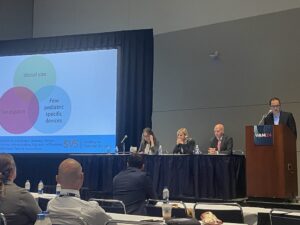 The focus of yesterday’s American Pediatric Surgical Association (APSA)-SVS task force’s spring quarterly interest group meeting at VAM 2024 was the “incredibly crucial” topic of pediatric trauma, as described by co-moderator John White, MD. Various speakers shared a series of predominantly case-based talks, with the importance of collaboration emerging as a key take-home message.
The focus of yesterday’s American Pediatric Surgical Association (APSA)-SVS task force’s spring quarterly interest group meeting at VAM 2024 was the “incredibly crucial” topic of pediatric trauma, as described by co-moderator John White, MD. Various speakers shared a series of predominantly case-based talks, with the importance of collaboration emerging as a key take-home message.
White, who is chair of surgery at Advocate Lutheran General Hospital in Park Ridge, Illinois, outlined the gravity of the topic at hand. “We lose 20,000 young lives each year from trauma,” he said, adding that trauma is the leading cause of death of all children over the age of one and exceeds the combined total of all other causes.
Furthermore, he noted that for every death, 40 children require hospitalisation for major injuries and thousands of others are treated in emergency rooms. These factors, he remarked, make this “an extremely important topic.”
The session featured presentations from co-moderator Dawn Coleman, MD, division chief of vascular and endovascular surgery at Duke University in Durham, North Carolina, J. Westley Ohman, MD, associate professor at Washington University in Saint Louis, Missouri, Luigi Pascarella, MD, associate professor at University of North Carolina at Chapel Hill, and Jayer Chung, MD, MS, associate professor at Baylor College of Medicine in Houston, Texas.
Delivering the final presentation of the session was Regan Williams, MD, medical director of trauma services at the Le Bonheur Children’s Hospital in Memphis, Tennessee, who delivered a presentation titled ‘Expanded support of the pediatric vascular trauma patient—the important of care processes and resources’.
“I think the previous speakers have shown that we have an increased number of pediatric vascular trauma patients, mostly related to the increased number of penetrating injuries that are affecting our children, and the vascular surgeons and pediatric surgeons have really been working well collaboratively together to save these children’s lives,” Williams began. “But what happens after you’ve repaired them, how do we get them back to normal life, how do we help them to be functional children and to live a very long, happy life after they’ve had these drastic injuries?”
Part of Williams’s talk focused on child life services, which the presenter noted is a relatively new field. “Child life uses play and developmentally appropriate communication to help inform hospitalised children and their families,” she explained.
“I think the best collaborative model for pediatric vascular injuries is an adult vascular surgeon that has tons of experience in the technical aspects, but really partnering with a pediatric surgeon and a pediatric hospital so we can support the other parts of the child—they’re really important for their long-term outcomes,” Williams said in her conclusion.
Closing out the session, Coleman summarized: “I’m taking away from this whole session that collaboration really matters in this space.”
White and Coleman co-moderated the session alongside Claudie Sheahan, MD, professor of clinical surgery at LSU Health in New Orleans, Louisiana.












